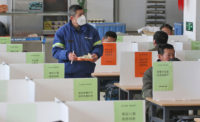While China’s COVID-19 infection rates have declined and business begins to return to some level of normalcy there, outbreaks in Italy and elsewhere continue to stoke fears of global supply chain hiccups.
[For ENR’s latest coverage of the impacts of the COVID-19 pandemic, click here]
Chris Williamson, chief business economist at IHS Markit, notes that both supply and demand are likely to be affected by coronavirus-related fears.
IHS Markit’s March 2 edition of the Manufacturing Purchasing Managers’ Index showed that “the backlog of orders moved to its highest level since April 2019—perhaps suggesting that companies are starting to deal with shortages of inputs,” says Richard Branch, chief economist at Dodge Data & Analytics.
Many Chinese manufacturing facilities sat idle for the month of February or longer due to the country’s virus containment efforts. However, the full impact to construction supply chains won’t become clear for several months, because “most projects typically have supplies in place well before ground is broken,” says Branch.
Some firms already are reporting delays. Dan Kaufman, regional president with JE Dunn Construction in Atlanta, says that an electrical subcontractor on one project estimates a two-month delay on materials procured from China. “It’s an immediate critical path impact of up to eight weeks on a job, which is obviously paralyzing, and we’ve got to figure a way around that,” he says.
Wisconsin solar plants fear project delays due to late shipments of components, while Georgia contractors say respirator masks are in short supply.
Christa Myers, pharmaceutical market director at CRB, says at least one project is being affected due to travel restrictions to Italy, a hotbed for manufacturing of pharmaceutical equipment. Testing and approvals for equipment on a project in the U.S. have been delayed, and staff that had recently traveled to Italy are now grounded. In fact, Myers is working from home for 14 days out of an abundance of caution after returning from Italy’s most impacted region.
In China and Hong Kong, people returning to work have also been delayed by quarantines, says Michael Kavanagh, managing director of S&techs, a Hong Kong-based affiliate of Structure Tone. In addition, building permits in Hong Kong and elsewhere have been delayed due to lack of staff to handle requests, he adds.
Elsewhere in Asia, Reuters reports that Indonesia’s $6-billion Jakarta-Bandung high-speed rail line is being delayed by the absence of approximately 300 senior-level workers and supply shortages of critical materials such as pipes and waterproofing. In Bangladesh, a $3.5-billion, 3.8-mile-long road and rail bridge across the Padma River is getting by with only two-thirds of its 980-person Chinese workforce.
“Unfortunately, economic data has not kept up with the rapidly changing news as it pertains to the COVID-19 virus,” Branch says. “Data in the weeks to come will be watched closely for signs of deterioration due to the virus. However, it’s a very strong likelihood that U.S. Gross Domestic Product growth in the first half of the year will be weak.”
By Scott Blair, Alisa Zevin, Debra K. Rubin, Scott Judy and Jim Parsons









Post a comment to this article
Report Abusive Comment